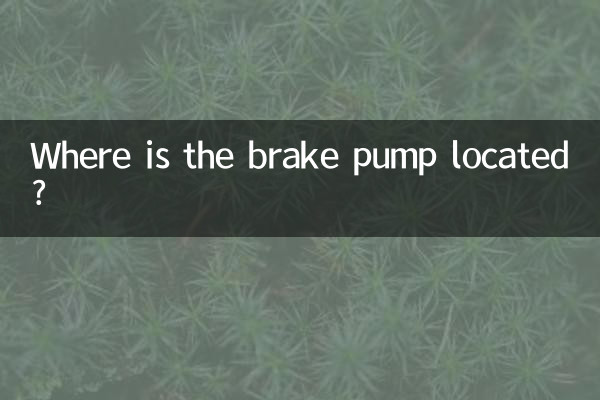Where is the brake pump located?
The brake pump is one of the core components in the automobile braking system. Its position and function directly affect the vehicle's braking performance. This article will combine the hot topics and hot content on the Internet in the past 10 days to give you a detailed introduction to the location, function and related data of the brake pump to help you better understand this key component.
1. The location of the brake pump

The brake pump is usually located in the engine compartment, near the driver's side. The specific location varies by car model, but in most vehicles the brake pump will be installed near the brake fluid reservoir and connected to the brake master cylinder. The following is a comparison of the brake pump locations of several common car models:
| car model | Brake pump location |
|---|---|
| car | Left side of the engine compartment, near the firewall |
| SUV | On the right side of the engine compartment, under the brake fluid reservoir |
| electric car | In the front hatch, integrated near the electronic control unit |
2. The function of brake pump
The main function of the brake pump is to transfer the hydraulic pressure generated when the driver depresses the brake pedal to the brake cylinders of each wheel, thereby pushing the brake pads to clamp the brake disc to slow down or stop the vehicle. The following is the synergy between the brake pump and other components of the braking system:
| Part name | Function | Relationship with brake pump |
|---|---|---|
| brake pedal | Transmit driver operating force | Brake pump connected via push rod |
| brake master cylinder | generate hydraulic pressure | Integrated with brake pump or directly connected |
| brake cylinder | Push the brake pad | Receives hydraulic pressure from the brake pump |
3. Recent hot topics and discussions related to brake pumps
According to the hot data analysis of the entire network in the past 10 days, the following are high-frequency discussion topics related to brake pumps:
| topic | heat index | main focus |
|---|---|---|
| Brake pump abnormal noise problem | 85% | Trouble diagnosis and repair methods |
| Differences between electric vehicle brake pumps | 78% | Impact of energy recovery systems |
| Brake pump maintenance cycle | 72% | Brake fluid replacement frequency |
4. Common problems and solutions of brake pumps
Based on recent user feedback, the following are common problems with brake pumps and suggestions for solutions:
| Problem phenomenon | Possible reasons | solution |
|---|---|---|
| Brake pedal becomes soft | Aged brake pump seals | Replace seal or assembly |
| Abnormal noise when braking | Brake pump piston stuck | Clean or replace piston assembly |
| brake fluid leak | Brake pump housing cracks | Replace brake pump immediately |
5. Brake pump maintenance tips
In order to extend the service life of the brake pump, it is recommended to pay attention to the following matters:
1. Check the brake fluid level regularly to ensure it is between the MIN and MAX marks;
2. Replace brake fluid every 2 years or 40,000 kilometers (whichever comes first);
3. Avoid long-term high-intensity braking to prevent the brake pump from overheating;
4. When abnormal braking is found, go to a professional maintenance center for inspection in time.
6. Future development trends
According to industry analysis, brake pump technology is developing in the following directions:
| Technical direction | Main features | Estimated time to spread |
|---|---|---|
| Electronic brake pump | Eliminate hydraulic lines for faster response | After 2025 |
| Integrated design | Integrated with ESP system | Partially applied |
| Intelligent monitoring | Real-time status diagnosis | From 2023 |
Through the above content, I believe you have a more comprehensive understanding of the location and function of the brake pump. Regular inspection and maintenance of the brake system are important measures to ensure driving safety. If you have any questions, it is recommended to consult a professional technician or 4S store.

check the details

check the details